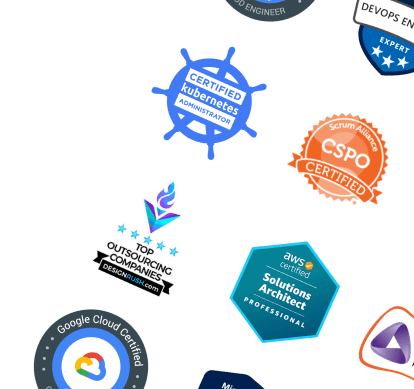Access to top tech expertise becomes more limited each year, creating steep barriers to further growth and cost optimization for many businesses.
According to the WTW report on top trends affecting talent and pay in the tech industry, finding and retaining digital skills is a challenge for 93% of respondents participating in their survey, especially in data analytics, software development, and AI.
Even more, the global talent shortage will result in 85 M unfilled positions by 2030, which will cost businesses $8.452B in unrealized revenues.
In this situation, businesses must act effectively and efficiently. When in-house hiring or upskilling programs slow beyond acceptable limits, it is wise to consider alternative methods, such as adding developers through IT staff augmentation or a dedicated team.
Below is the IT Craft’s guide on how to hire software developers for your project.
1
Why Hire Top Developers?
Although hiring the best software developers is taxing, the benefits are bountiful. Companies that know how to hire the best software developers enjoy:
- optimized processes
- improved ROA (return on assets), 16.2% for top performers compared to 3.5% for tech laggards
- improved cost-effectiveness
- transformational capacity needed for sustainable growth
Based on a report by Boston Consulting Group, businesses investing in competent software developers grow 50% faster than their competitors.
Here is how talented software developers increase companies’ bottom lines:
Experienced software developers have higher performance and positively affect the entire company. According to a study by the National Bureau of Economic Research, when the company increases the number of top-performing developers by 1%, it leads to a 4% boost in company’s productivity in return.
- Creativity and disruption
Top talents work proactively. Finding solutions to its identified challenges helps the company gain a completely different position in the market and leave principle competitors behind. Companies should listen to their top talents and find the best application to their skills. When talented engineers see no growth opportunities within a company, they will do it independently by creating a startup.
Remember Steve Wozniak offered his computer design to Hewlett-Packard. HP refused. The rest is history of which HP played no part.
Experienced and talented developers think several steps ahead. They produce flexible, modular architecture that is easy to expand and maintain. Total cost of software ownership decreases.
Also, clear maintainable code increases chances of retaining developers for a longer time.
Top-level engineers focus assiduously on security and quality assurance, enabling businesses to eliminate data breaches and user privacy issues. (Data breaches are a money pit. Lack of security for user privacy is illegal.)
According to a McKinsey report, within the last three years alone, regulators fined North-American tech companies over $5B for failing to comply with data rules and provide information on breaches and affected data.
- Brand reputation and trust
According to another McKinsey survey, consumers equate data protection and trustworthiness as important as price and convenience. 46% of all consumers seriously consider moving away from a company when its privacy policy and use of users’ personal data is unclear.
Hence, it is crucial to outline a transparent privacy policy and hire top software developers capable of implementing it.
2
Challenges of Choosing Staff Augmentation Provider
Be where 38% of leading IT companies are: they use staff augmentation when top talents are unavailable for a quick hire in a domestic market. Instead, broaden your search and outsource at least some of your tasks.
Still, risks remain that your chosen staff augmentation isn’t a good fit for you—more time wasted! To avoid this, you (as a client) must carefully focus on potential pitfalls.
Keep these in mind throughout your vendor selection process:
Cost savings are among the top reasons for outsourcing. However, they become slim to none when source code quality is low. CISQ estimates losses of US companies caused by poor software quality by $2.41T in 2022. The long-term reasons for increased expenses include:
- delayed deliveries
- high support and maintenance costs
- inability to scale/expand
Check the company portfolio. Read reviews and recommendations from former clients to evaluate the quality and complexity of completed projects.
Expertise has a direct impact on team performance and quality. Expert teams take over client requirements or an existing project quickly and effectively. They have the same mind stack as your in-house team, initiating clear communication.
Go through the company’s website and profiles in directories to get a clear impression. Check reviews on how its engineers perform and how well they get on with clients.
Trust is the top concern for many companies seeking to enhance their team. Unreliable developers could ruin all your project processes.
A thorough preliminary research is essential. Check the company’s cases. Read reviews from clients on Clutch while evaluating project size and complexity. Pay attention to recommendations.
If doubts exist, ask for references. Start small with a pilot task to see the engineering routine and approach to task completion.
Scalability is crucial for adapting to evolving project requirements.
According to a Project Management Institute (PMI) report, 69% of projects suffer from limited scalability. When you wish to hire software developers on a long-term basis, it is always wise to discuss team growth possibilities with a prospective partner or look for a vendor capable of adding developers quickly.
Of note: If project-based cooperation is planned, limited scalability does not pose a problem. You will transfer the completed project to a new, bigger team.
Speed matters.
Atlassian State of software development report states 57% of companies prioritize speed of delivery. The vendor’s developers must be able to work autonomously while also able to coordinate their efforts with the entire team. They must be an asset for you to achieve regular, consistent deliveries.
Select the provider with an established workflow and completed projects on automation and optimization. Ask about team reaction to unforeseen challenges. Ensure everyone has a clear vision of how to meet them.
3
What to Look for When Hiring a Developer (Nine Key Factors)
Just as with in-house team members, recruiting software engineers involves three steps: pre-selection, selection, and post-selection.
These steps let you form your expectations, filter candidates, and onboard them effectively, which is crucial for productive cooperation.
At each step, you should focus on how to hire a developer that both meets your project needs and is a great cultural fit.
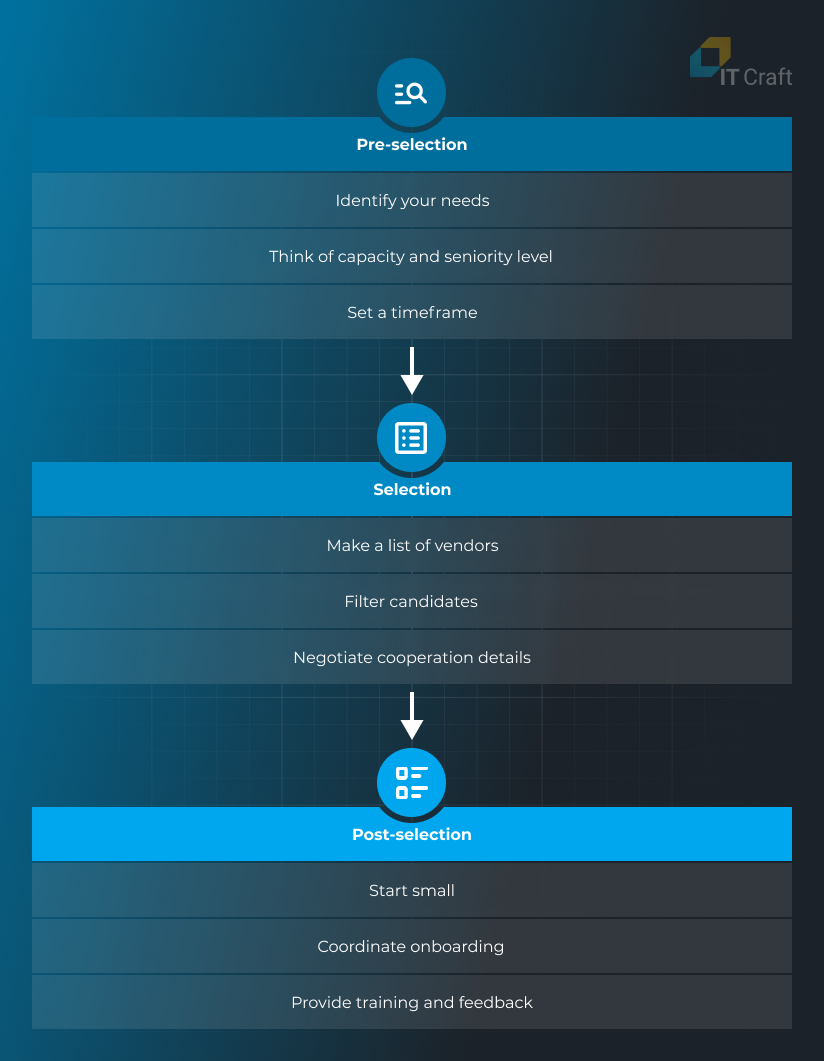
Here are some important considerations on how to hire a software developer successfully:
PRE-SELECTION
It makes sense to start with planning and clarification:
01 Identify your needs.
Needs are different. You might:
- seek specific, rare expertise
- increase capacity
- make an urgent replacement
- optimize costs
- establish a long-term partnership
Decide why you want to hire software developers for team augmentation. Prioritize your needs and narrow your search criteria. This prioritization helps you understand better how to hire software engineers.
Set the right expectations for the new team member(s).
02 Think of capacity and seniority level.
Determine what skills you need and how much scope you want to cover with external force—you might need several specialists.
Consider lowering the seniority level to close positions faster. Obviously, middle-level engineers are less rare and expensive.
Add a dedicated project manager when your onsite management is overloaded with tasks.
03 Set a timeframe
Set a completion date. But be realistic about the time you need to hire the best software developers.
Make sure you have enough time to:
- understand core gaps and required expertise level
- do proper market research
- understand expertise level of a vendor
- remove ambiguities in contract details
- return to previous vendor choice if your first choice does not pass during probationary period
SELECTION
Focus on careful vendor selection even if hiring time is limited:
01 Make a list of vendors.
Look for evidence of successful experience relevant to your requirements, ensuring you hire the best software developers for your project.
First-hand experience is the best. Ask friends and colleagues for recommendations. If those recommendations have no or less-than-perfect experience, browse through the best places to hire developers where you can read real feedback, such as Clutch, Goodfirms, or Upwork.
Check company websites. Go through cases, offered solutions, and client testimonials. Make sure your selection provides the services you need.
Make a list of 5 – 10 vendors to contact for candidates.
02 Filter candidates.
This step consumes considerable time and effort. You must carefully evaluate available options in order to select the best one.
Send requirements to the selected vendors. Study their response.
For instance, it takes IT Craft 3+ business days to:
- Pick up engineers matching main criteria (hard skills, working style, and values alignment).
- Check their availability.
- Send CVs to the client and schedule interviews.
- Look for the best balance during interviews with engineers.
Select candidates who have necessary technical expertise, respond fast, and provide a track record of successful cooperation.
Do you need external developers to start as soon as possible?
Share your concerns with us to see how we could help you move forward your project.
Contact Us
03 Negotiate cooperation details.
Take extra care during this step to eliminate unrealistic expectations. Discuss cooperation details, including:
- access and security policies
- availability within specified hours
- communication and reports (frequency and formats)
- contact point on the vendor’s side (in case any emergencies occur)
- timeline and budget limitations
- renewal options
Cover specified points in the agreement with the IT staff augmentation services provider.
Decide on contract terms that fit best to your project constraints:
- managed services
- time and materials
- fixed price
POST-SELECTION
Onboarding matters. If you want hired software developers to maximize their abilities, you must provide proper integration in the company processes:
01 Start small.
Start cooperation with a new vendor by assigning a pilot task or setting a probationary period. Both help you test your expectations against reality.
On one hand, you carefully evaluate new team members’ performance and attitude before trusting them with important tasks. On the other, probation is the time to adjust processes when remote cooperation from different time zones has never been a part of your plan. You check workflow for bottlenecks and conflicts.
02 Coordinate onboarding.
Delays occur when software developers do not start working because they lack access to the specific client resources.
Hence, it is essential that you:
- Grant required permissions to tools and infrastructure.
- Provide unrestricted access to knowledge base.
- Appoint people on your side to respond when questions arise.
Add augmented staff into your workflow, e.g., create corporate accounts, whitelist IPs, or add to the task board/internal Slack channels.
03 Provide training and feedback.
Treat every developer as part of your team.
Do not leave external software developers alone. Initiate training when specific policies apply and explain how things work on your project.
To facilitate cooperation, provide vendors and developers feedback after receiving their reports.
Also, encourage developers to express their reasoned suggestions and opinions. An outsider’s look may help you streamline processes, enable more deliveries within the same timeline, or increase software consistency.
4
What to Avoid When Hiring a Developer
Risks exist that a shortlisted developer or team cannot handle the requirements efficiently and will rather slow down the project rather than improve its pace.
The issues leading to project deterioration can include:
- lack of understanding of the client’s vision
- miscommunication due to cultural barriers
- chaotic processes at the provider’s side
- insufficient expertise by assigned engineers
- dishonest company
How can you avoid the risks of hiring irrelevant developers?
The following important points will let you timely detect a less-than-perfect fit and avoid disappointing hires:
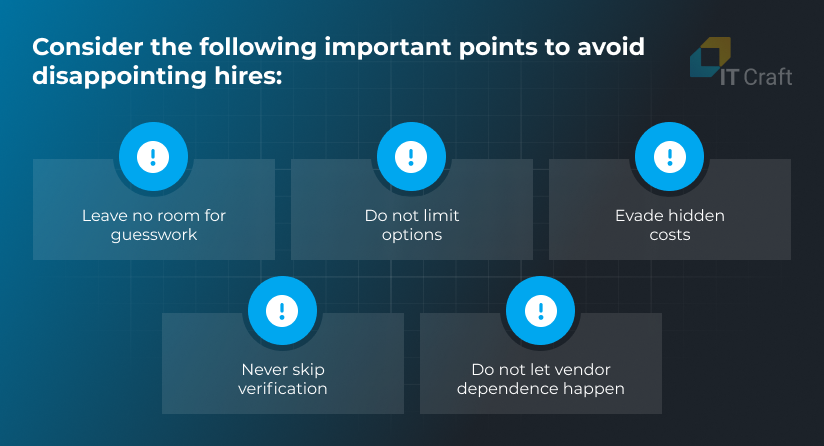
- Leave no room for guesswork
Ensure 100% clarity between you and developers. They understand your goals, concerns, requirements, and limitations. Be clear about your expectations from staff to eliminate conflicts, e.g., the hired software developers must provide at least a 4-hour overlap with your business hours.
Think about where to hire developers and change your search criteria when vendors from the selected location fall short of your standards. For instance, software developers from Southeast Asia might provide the least expensive hourly rate but not be a good fit due to the significant time difference hampering good communication.
A dishonest provider could be a problem. The vendor might want to hook you with an enticingly low estimate, hoping to sign a contract then later increase costs of provided services via upsells.
When you see an estimate that is “too good to be true” with no clear itemization of what services are included, it is wise to look for an alternative.
Dishonest providers often use this trick: they assign a senior engineer who impresses you with their expertise and experience during the interview. Then, they provide you with a less experienced replacement.
Schedule an interview with each single developer. Check each developer’s identity when they start their work for you.
- Do not let vendor dependence happen
You, as an owner, must keep fundamental control over your software product. Ensure hired software developers update project documentation and share their accomplishments with your team.
If developers do not provide knowledge transfer, you might inadvertently slip into risky dependence. Avoid this.
5
Define What Type of Developer You Want to Hire
It is critical to understand your ideal candidate clearly. Being aware of the required skills and responsibilities as well as expertise level will let you hire a software programmer needs without overspending.
Expertise level
Based on expertise level, you can hire:
- Junior – works on simple, entry-level tasks under supervision of experienced developers.
- Middle – knows several development tools; works independently using best development practices.
- Senior – high-level position, engineers with comprehensive software development, troubleshooting, and optimization knowledge.
- Principal – highly advanced position, decides on strategic aspects such as software architecture, development direction, etc.
An important note. Determine your exact needs regarding scope, complexity, and tech stack. You save by assigning specific tasks to the right person.
For instance, middle engineers are less expensive than principal engineers. However, due to poor architectural decisions, asking them to design project architecture will cost you a budget for product redevelopment.
On the contrary, assigning trivial coding tasks to a principal engineer is overkill due to a high hourly rate. You might think about how to find software developers who are less experienced and expensive.
Skills and specialization
Team roles a different in a development team. Based on skills, you can look for:
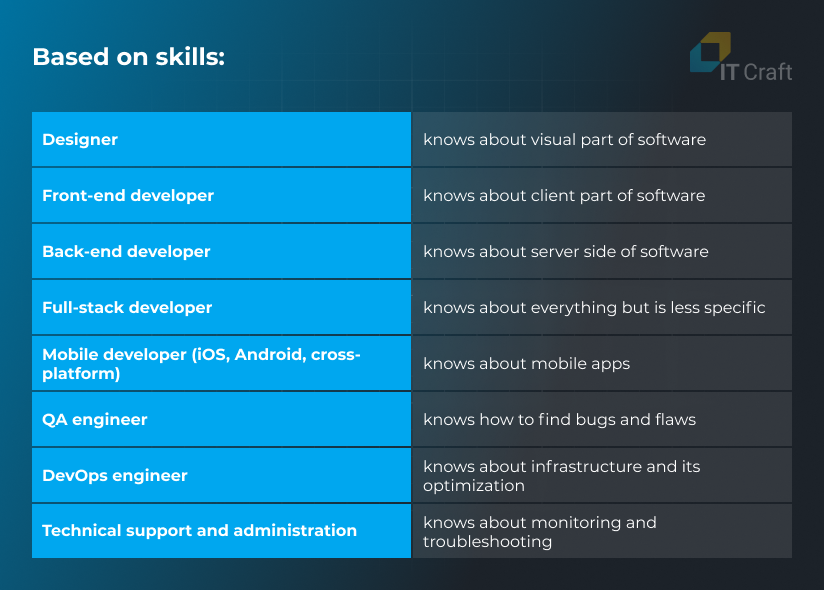
You might need all these roles on your project if you have no engineers or only a CTO in your in-house team.
You can also add certain vacant roles, such as DevOps engineers or full-stack developers, which you might struggle to fill quickly or which you need on a short-term basis.
6
Benefits of Our Software Developers
Being in the market since 2001, IT Craft delivers on time and budget to its clients from North America, EU, Australia, and Middle East.
The company invests in development culture, constant learning, and process optimization to ensure that software deliveries are:
- transparent
- predictable
- uninterrupted
As a client, you enjoy working with a reputed provider and getting access to:
Expertise
The result is faster because of improved productivity. Project architecture is based on your long-term plans to simplify your growth.
Cost optimization
You save up to 50% of your initial development budget due to a lower hourly rate compared to the local market and elimination of indirect costs.
Immediate project start
Engineers start working once you have approved their candidatures and cooperation details. You keep up with an aggressive deadline.
Scalability
Do you need to handle seasonal workload spikes or constantly growing scope? You can add talents both on short- and long-term basis, as many as required.
Flexibility
IT Craft’ wide talent pool lets you add specific experts for changing requirements needed to improve consistency, expand functionality, or scale your system.
Knowledge sharing
Apart from well-commented source code, you receive updated project documentation. IT Craft engineers help with consulting when requested.
7
IT Craft Expertise
IT Craft clients enjoy a proven, straightforward path to successful cooperation. Five steps apply:
01 Initial request.
Send us a description of your needs.
02 Selection.
We check your requirements and limitations, then select the best developers, matching your criteria.
03 Conduct interviews.
We coordinate interviews, ensuring you can evaluate skills and make your own impression.
04 Candidates and cooperation approval.
Once you approve candidates you prefer, we manage all agreement details together, eliminating misunderstandings.
05 Onboarding and kickoff.
When the agreement is finalized and signed, developers integrate into your team, working on assigned tasks.
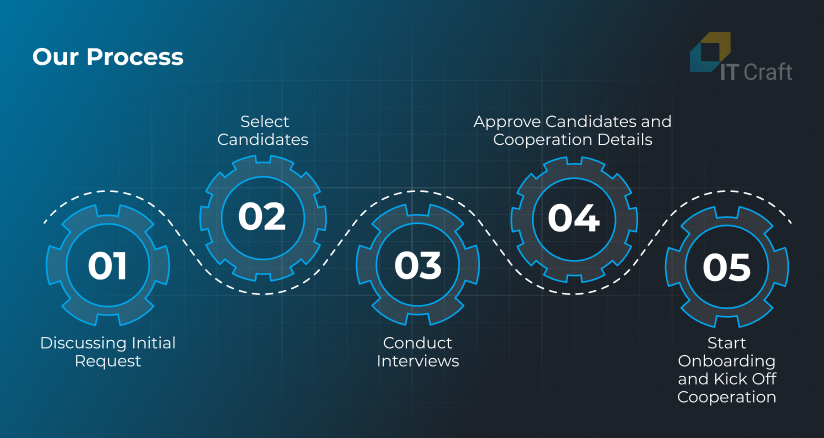
Below are three of many examples when IT Craft talents increased client’s bottom line by taking over software development activities:
Adorama
Adorama’s ecommerce platform powers six retail businesses. The need for fast team scaling emerged when the client’s in-house team faced platform modernization, expansion, and maintenance.
What the client needed
The client sought high performance: each extra millisecond would drive away customers from purchase.
How we helped
IT Craft assigned an engineering team that quickly expanded. The team was composed of software engineers, QAs, and system administrators. It focused on tech realization of the client team’s vision, ensuring constant updates, top performance on user devices, and 99.8+ availability.


MyPlace Connect
The startup built a custom marketing system to increase customer loyalty, receive feedback, and send personalized offers.
What the client needs
The client’s focus on growth and improvement required a team that could help migrate to new infrastructure and scale the system efficiently.
How we help
The IT Craft senior DevOps team analyzed the client’s needs and offered a migration plan. The team then worked on gradual migration. Now IT Craft helps with maintenance and updates, improving software consistency and uptime.
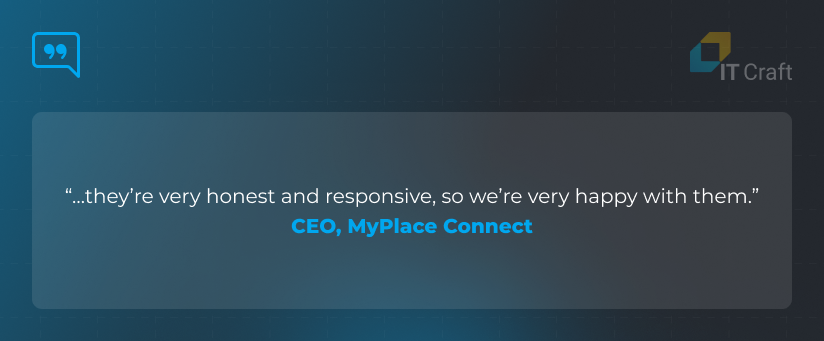
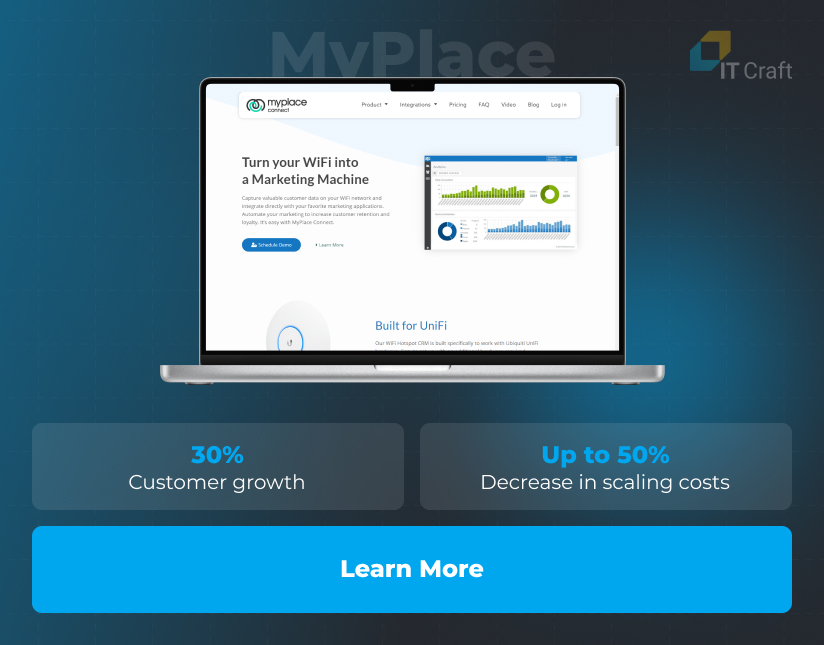
Amesto
The client was a major Scandinavian translation agency. Its customer portal streamlined customer access to translation services.
What the client needed
The company focused on its expansion and improvement and needed development experts capable of working efficiently under growing scope.
How we helped
IT Craft assigned software engineers who worked directly with the client, acting as part of the team. IT Craft developers completed required tasks on time, helping Amesto gain a competitive edge in the market. For instance, they integrated machine translation functionality eligible for handling sensitive information.

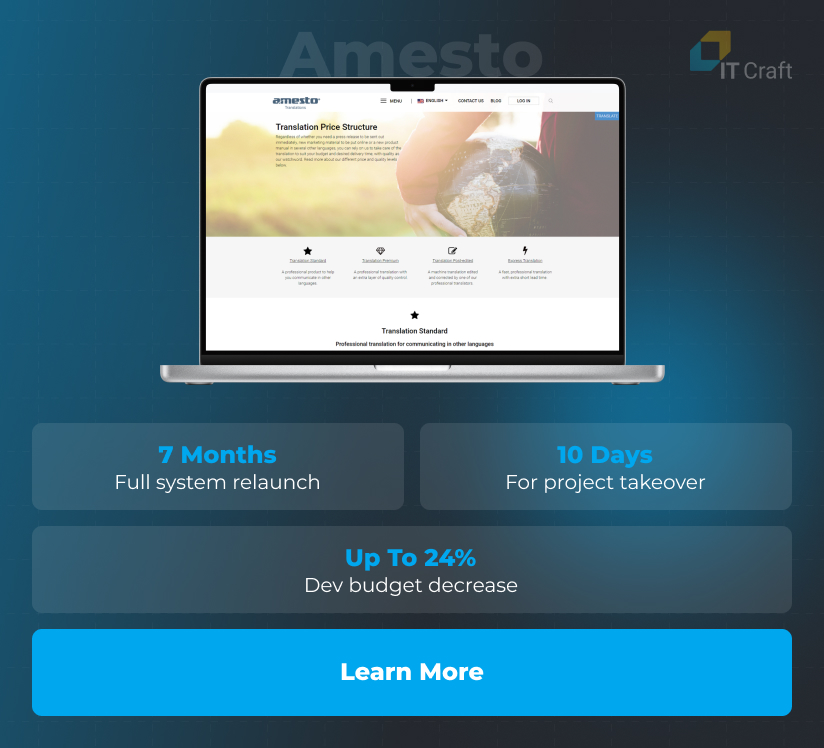
Are you looking for software developers who are ready to deliver?
Send us your requirements, and we will send you the CVs of the best-matched candidates from our talent pool within three working days.
Contact us
!
Summing Up
IT staff augmentation services can help you close talent gaps efficiently.
However, you should choose wisely. Every unsuccessful cooperation will cost you not only money wasted but lost time.
You need a proven, reputable vendor who knows how to help you and provides a good fit in terms of costs, scalability, and working culture.











